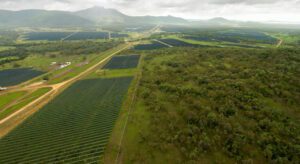Solar arrays that promise to generate happier, healthier cows and crops, while producing cheap electrons on the side, are being put into practice in France, following a series of government-led energy tenders with a difference.
Spanish energy giant Iberdrola has won contracts to develop four solar projects with a modest capacity of 3 megawatts (MW) each, but what is interesting about these projects is that the primary focus is not on output, but on the benefits that solar panels can deliver to agricultural productivity.
To really drive home this focus, the French government used contracts for difference where the price per MWh is set for 20 years above the market value to compensate for the prioritisation of agriculture and livestock over maxmimum solar production.
In the first project, dubbed Kirch, Iberdrola will mount solar panels 1.5m above the ground to allow dairy cattle to shelter underneath.
The panels will also collect and store rainwater. Predictive software will then either activate irrigation systems when needed, or use data from smart collars worn by cows to start ‘foggers’ to cool the animals on extreme heat days.
The other three projects, Maubec, Lapenche and Solomiac, will focus on crops and maximising land productivity.
Tracker technology normally used to rotate panels towards the sun will instead be used for shading, to protect crops from frost in winter and intense sunlight in summer. The panels will be installed in rows from north to south at an angle between -70° and +70° and informed by ground sensors.
Iberdrola says the panels will be installed far enough apart to allow tractors between them.
Cattle and solar don’t mix
Iberdrola’s innovation will be to find a way to successfully make crop rotations economically viable at its three agriculture projects and for solar panels to work with cattle – big animals that love a good scratching post.
In Australia, cattle-plus-solar hasn’t been nearly as popular as sheep-plus-solar, a trend Wyngery’s director Ben Wynn says comes down to the added costs of having to mount the panels higher off the ground in paddocks with cows.
“We built a 60 kilowatt prototype at Farrer Memorial Agricultural High in Tamworth which is an awesome piece of engineering, it runs perfectly… but compared to a ground based tracking system you’re looking at a cost of about 160 per cent more,” he told RenewEconomy.
“I think I can get that down to 80 per cent, but it’s still high. Developers in this country will choose one form of infrastructure over another because it’s one point of a per cent cheaper in CAPEX rather than 80 per cent dearer.”
A 1P tracking system uses one panel about 2 metres off the ground roughly spaced 6-8 metres apart, which at midday when the panel is effectively horizontal gives very little access to other users.
A 2P tracking system uses two panels that are 2.2-2.4 metres off the ground and 12 metres in between, which provides enough access to even re-sow pasture in between.
“While 2P costs 2-4c per watt more to install, our modelling shows that you can offer the farmer a reduced lease rate and then also shift the vegetation management on to them, so you don’t have to mow or spray and they check the fences. You remove ongoing OPEX costs so ongoing IRR moves up 2-3 per cent,” Wynn says.
Studies show it works for sheep and horticulture
The emerging combination of complementary solar and farming practices has been dubbed ‘agrisolar’, as both industries seek to make land work double time and mitigate rising complaints about the transition of “prime agricultural land” into solar farms.
State funded AgriSolar Clearinghouse in the US estimates that some 3 million acres of land will be under solar by 2030, or 0.33 per cent of total farmland, while the Clean Energy Council estimates 0.027 per cent of Australia’s current farmland.
“Combining farming and solar in agrivoltaics presents a powerful path forward, increasing social licence for renewable energy developments and allowing ongoing agricultural use of productive land,” wrote farmer and renewable energy proponent Karin Stark in the report last year Farm Powered.
Stark says the likes of Japan, Denmark and Germany have been cropping under “agrivoltaics” for years, which provide benefits such as higher soil moisture, reduced exposure to extreme weather, and better ambient temperatures.
Agrisolar installations include ground level and mounted solar panels, greenhouses and rooftop panels, and even floating solar used in combination with aquaculture, according to a paper by the Clean Energy Council in 2021.
US studies have proven better yields or more efficient water use for tomatoes, broccoli, chard, and jalapenos for ground-mounted solar.
Crops likes wheat can be grown under elevated solar panels, but one US study showed that rotating these is not cost effective so permanent plants such as berries or nut trees are more viable.
Solar grazing is very popular in the US and Europe, and the first project in Australia began at the Royalla Solar Farm in 2015. By 2020 there were 13 known large-scale solar farms grazing sheep in the country, mainly in NSW but also in Victoria and Queensland.
For solar farm operators the pairing provides free lawn mowing and organic vegetation management, delivers extra monitoring when farmers are regularly on site, and strengthens relationships with neighbouring landholders. For farmers, sheep grazing on solar farms provides land with protection from the elements, lower water consumption by stock, and paddocks with secure fencing from predators.








